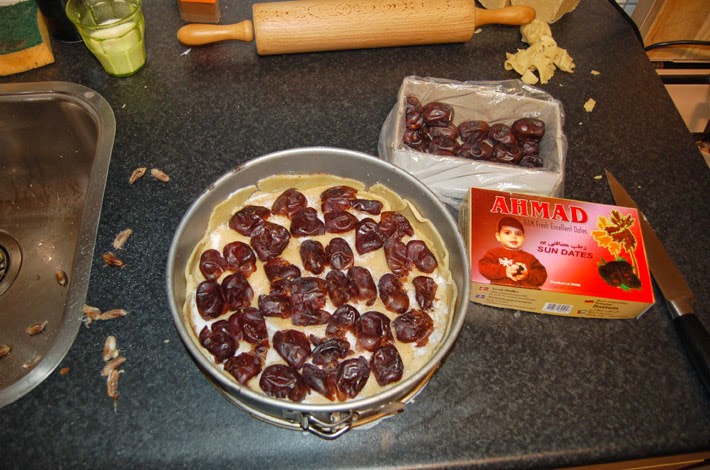Last weekend, the re-enactment season of this year started for us with a visit to the Historic Open Air Museum in Eindhoven. This meant preparing some dishes in advance as well. One of these was the extremely delicious 'Torta in balconata' or 'tiered dried fruit pie'. The torta has several layers of dates, walnuts and raisins with dough layers in between. Easy to make, to take with you, and very, very tasty.
Take the whitest flour you can get, three libra in quantity, and take two oncie of sugar and take a libra of almonds, and thrity-six good walnuts, and half a libra of raisins, and twenty-five dates, and half a quarto of cloves; and take a good quantity of almond milk; take the flour, moistened with water to make it very thick, and take the pan and grease it well with oil; make a crust from flour with crushed sugar and the aforementioned spices; take the walnuts, then the chopped dates and well-washed raisins, and the red cloves; and put a crust between each layer, and put a crust on top of all these things to make a torta.
Torta in balconata
The recipe is given in three parts: the pate brisee or the dough, making the almond milk, and preparing the pie.
Pate brisee:
- 3 cups of flour (450 g)
- 14 tablespoons cold butter (200 g)
- 2/3 cup water (around 18 cl)
- 1 teaspoon of salt
Prepare the pate brisee at least an hour in advance. Cut the cold butter into small pieces and rub the flour into it until the mixture has the consistency of sawdust. Dissolve the salt in half the water, and add to the flour mixture. Combine quickly with your fingertips, without overworking, just until the dough comes together. If necessary, add more water as required. Form into a disk or ball, wrap in plastic wrap and leave at least an hour to rest in the refrigerator. I usually make this dough a day in advance, resting it in the fridge.
Left: the cold butter and flour with the consistency of sawdust. Right: the finished pate brisee, before being put in the fridge.
Almond milk:
- 1 cup almonds (150 g)
- 1 litre water
Prepare the almond milk by grinding the blanched almonds in a food processor and adding half the amount of warm (60-70 degrees Celsius) water to it. Mix again with the food processor. Put the mixture through a cheesecloth lined in a strainer. Hold a bowl under it. I found that adding the cheesecloth is not really necessary; the ground almond particles already line the strainer as a natural sieve. Put the almonds back in the food processor and add the rest of the water. Repeat the process. The remaining ground almonds can be used in baking (cookies) or in a soup such as cream of chicken.
Left: the white almonds in the food processor, just before grinding. Right: the ground almonds in the strainer can be used a second time to extract the almond milk.
Catching the almond milk. No extra cheesecloth in the strainer is necessary to get a clean almond milk.
Pie filling:
- 2 tablespoons of sugar (25 g)
- 1/3 teaspoon ground cloves
- 1/2 cup raisins (75 g)
- 18 walnuts, shelled ( = 36 half walnuts)
- 13-16 fresh dates
Preheat the oven to 220 degrees Celsius. Divide the dough into thirds. Roll the first third into a circle large enough to line a deep 22 cm tart pan. Cut off the excess parts of the dough. On your work surface sprinkle the pastry with some of the sugar and the cloves and press them into the dough with the rolling pin (or your hand). Line the tart pan and arrange the walnuts on the sugared pastry. sprinkle liberally with almond milk.
Left: a third of the dough is rolled out in a rough circle. Right: the tart pan is used to measure the circle of dough and the remainder of the dough is cut of.
Left: the dough is sprinkled with sugar and ground cloves. Right: the halved walnuts are arranged on the dough.
Left: the walnuts are liberally sprinkled with almond milk. Right: a layer of dough is added on top of the walnuts.
Divide the second third of the dough in half and add the pieces of dough that remained from the first third. Roll one piece into a thin circle that will fit into the tart. Cut of the excess pieces of the dough. Sprinkle with sugar and cloves and press them into the dough. Place this on top of the walnuts. Half the dates, remove the pit and arrange them on top of this layer of dough. I preferably use Iranian sun dried dates, these are the best to use for the torta. Sprinkle the dates liberally with almond milk. Roll out the other small piece of dough (with the excess dough of the previous layer added) as before and place it on top of the dates.
Left: the fresh sun-dried dates added on top of a new layer of dough. Right: and sprinkled with almond milk.
Arrange the raisins on top of this layer and sprinkle liberally with almond milk. Roll out the rest of the dough and cover the pie, sealing the edges well. Bake for at least an hour and check if the top of the pie has turned a golden brown. My torta in balconata took 1.5 hour to bake.
Left: the dried raisins added on top of the next layer of dough. Right: and sprinkled as well with almond milk.
Left: the torta just after 1.5 hours from the oven. The crust is golden brown. Right: The cut torta showing the alternating layers (balconata) of dried fruits and dough.

The finished torta in balconata.

































